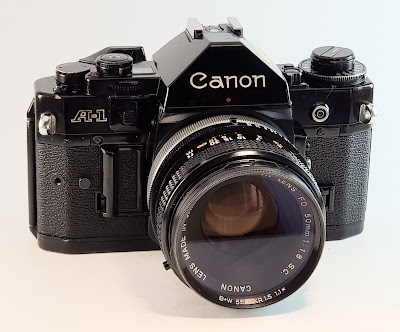History and technical features
The Canon A-1 is an advanced level single-lens reflex (SLR) 35 mm film camera for use with interchangeable lenses. It was manufactured by Canon Camera K. K. (today Canon Incorporated) in Japan from April 1978 to 1985. It employs a horizontal cloth-curtain focal-plane shutter with a speed range of 30 to 1/1000 second plus bulb and flash synchronization speed of 1/60 second. It has dimensions of 92 millimetres (3.6 in) height, 141 millimetres (5.6 in) width, 48 millimetres (1.9 in) depth and 620 grams (22 oz) weight. Unlike most SLRs of the time, it was available in only one color; all black. The introductory US list price for the body plus Canon FD 50 mm f/1.4 SSC lens was $625, the camera was generally sold with a 30–40% discount (roughly $375 to $435).
The A-1 is a historically significant camera. It was the first SLR to offer an electronically controlled programmed autoexposure mode. Instead of the photographer picking a shutter speed to freeze or blur motion and choosing a lens aperture f-stop to control depth of field (focus), the A-1 has a microprocessor programmed to automatically select a compromise exposure based on light meter input. Virtually all cameras today have at least one program mode.
Beginning with the amateur level Canon AE-1 of 1976, there was a complete overhaul of the entire Canon SLR line. The 1970s and 1980s were an era of intense competition among the major SLR brands: Canon, Nikon, Minolta, Pentax and Olympus. Between 1975 and 1985, there was a dramatic shift away from heavy all-metal manual mechanical camera bodies to much more compact bodies with integrated circuit (IC) electronic automation. In addition, because of rapid advances in electronics, the brands continually leapfrogged each other with models having new or more automatic features, and less expensive components and assembly. The industry was trying to expand out from the saturated high-end professional market and appeal to the large mass of low-end amateur photographers keen to move up from compact automatic leaf shutter rangefinder cameras to the more "glamorous" SLR but were intimidated by the need to learn all the details of operating a traditional SLR.
The A-1 is the high technology standard bearer of the landmark Canon amateur level A-series SLRs. The other members of the A-series are the Canon AE-1 (released 1976), AT-1 (1977), AV-1 (1979), AE-1 Program (1981) and AL-1 (1982). They all use the same compact aluminum alloy chassis, but with differing feature levels and outer cosmetic acrylonitrile-butadiene-styrene (ABS) plastic panels. By sharing most major components, and an inexpensive horizontal cloth-curtain shutter, costs could be spread out over a larger production volumes. The A-1 represented Canon's bid to defeat Nikon through more features and the cheapest price.
The A-1 caused a sensation when it was released in early 1978. Most photographers were amazed at its advanced features, years ahead of the competition, but in the face of changing technology, not all comments were positive. Professional photographers worried about the long term reliability of its consumer-level mechanical and electronic components under heavy daily use, the relatively slow flash sync and top shutter speeds. Traditionalist photographers complained about an "excess" of automation ruining the art of photography, a criticism that was leveled at all of the newly automated cameras released in the 1980s. However, automation turned out to be the right way to entice many new amateur photographers on a budget, and paid off very well for Canon.
The Canon A-1 was a runaway best seller, as it offered new SLR buyers considerable features and value for the price. It was reliable for its day in amateur usage. But as competitors brought out their own programmed SLRs,[1] the A-1 began to show its age. This is especially true for its horizontal cloth-curtain shutter, viewfinder information display and autoflash control. The A-1 was due for replacement when the Canon T90 came out in 1985. Canon's abandonment of the FD lens mount for the EOS design also had a significant effect on demand for the A-1 on the used market. But it is still regarded as one of the most fascinating SLRs of its generation and many are still in regular use.
Source: en.wikipedia.org
Specifications
The A-1 accepts any lens with the Canon FD breech lock mount (introduced in 1971) or Canon New FD pseudo-bayonet mount (sometimes called the FDn mount, introduced 1979). It can also use most earlier FL lenses and some even older R (or Canomatic) series lenses, albeit with reduced functionality. This excludes all of Canon's EF bayonet mount autofocus lenses (introduced in 1987). During the late 1970s and 1980s, there were approximately 55 Canon FD lenses available for purchase. They ranged from a 7.5mm f/5.6 fisheye to an FD 800mm f/5.6 telephoto, and included lenses with maximum apertures to f/1.2 and a line of L-series lenses of exceptional quality. Accessories for the A-1 included the Canon motor drive MA (automatic film advance up to 5 frames per second), the Canon Databack A (sequential numbering or date stamping on the film), and the Canon Speedlight 155A (guide number 56/17 (feet/meters) at ASA/ISO 100) and Canon Speedlight 199A (guide number 98/30 (feet/meters) at ASA/ISO 100) electronic flashes.
The A-1 is a battery-powered (one 4LR44 or PX-28) microprocessor-controlled manual-focus SLR with manual exposure control or shutter priority, aperture priority or programmed autoexposure. A fifth mode is "stopped down AE", in which the aperture is closed and alterable by the photographer and the camera selects the shutter speed based on the actual light reading. This differs from aperture priority in which the aperture is not closed until a photograph is taken and the shutter speed is calculated based on the light measured through the fully open aperture. Stopped down AE existed so that old FL lenses could be used with at least some kind of AE, and was also useful for photomicroscopy, manual-aperture lenses, etc. The A-1 is the first SLR to have all four of the now standard PASM exposure modes. It has a viewfinder exposure information system using a six-digit, seven-segment per digit, red alphanumeric LED display on the bottom of the viewfinder to indicate the readings of the built-in centerweighted, silicon photocell light meter. The focusing screen also has Canon's standard split image rangefinder and microprism collar focusing help.
Source: en.wikipedia.org
- Type:35mm focal-plane shutter SLR camera
- Picture Size: 24 x 36 mm
- Normal Lens: Canon FD 55mm f/1.2 SSC, FD 50mm f/1.4 SSC
- Lens Mount: FD mount
- Shutter: Four-axis, horizontal-travel focal-plane shutter with cloth curtains. X, B, 30, 15, 8, 4, 2, 1, 1/2, 1/4, 1/8, 1/15, 1/30, 1/60, 1/125, 1/250, 1/500, 1/1000 sec. All speeds controlled electronically. Built-in self-timer (with 2- and 10-sec. delay and blinking LED). Multiple exposures enabled with a lever. Electronic shutter release.
- Flash Sync: X-sync automatic-switching sync contacts with German socket and hot shoe.
- Viewfinder: Fixed eye-level pentaprism. 0.83x magnification, 93.4% vertical coverage, 95.3% horizontal coverage. Split-image rangefinder encircled by microprism rangefinder at center of fresnel matte screen. Eyepiece shutter provided. Six interchangeable focusing screens optional (installed by service personnel). The standard screen was later replaced by the brighter and sharper Laser Matte screen.
- Viewfinder Information: Digital readout with 7-segment red LED for shutter speed, aperture, dedicated Speedlite flash-ready, manual settings, and warning displays.
- Metering & Exposure Control: SPC for TTL full-aperture centerweighted averaging metering or TTL stopped-down metering. Exposure compensation range of 2 EV. AE lock provided. Five AE modes: Shutter speed-priority AE, aperture-priority AE, program AE, preset aperture-priority AE, and Speedlite AE (with dedicated Speedlite). The mode is set with a selector dial. Metering range at ISO 100 and f/1.4: EV -2 – 18. Film speed range from ISO 6 to 12800 in 1/3 steps.
- Power Source: One 4G-13 6 V mercury oxide battery or 4LR44 alkaline battery. Battery check with button and blinking LED.
- Film Loading & Advance: Slotted take-up spool. Advances with camera-top lever’s 120 stroke (partial strokes enabled). Ready position at 30.
- Frame Counter: Counts up. Resets automatically when camera back is opened. Counts down during rewind.
- Film Rewind: Camera-top crank
- Dimensions & Weight: 141 x 92 x 48 mm, 620 g
Source: global.canon
Model
Serial number 1412230
Reference sites
en.wikipedia.org
global.canon
mir.com.my
Manual
English manual
Canon A-1 Repair Guide
Batteries
 |
| V28 PX 6V battery |
 |
| Kodak ColorPlus 200/24 |
 |
| Fujicolor C200/36 |
Pictures taken with this machine
 |
| Kodak ColorPlus 200/24 sample 1 |
 |
| Kodak ColorPlus 200/24 sample 2 |
 |
| Kodak ColorPlus 200/24 sample 3 |
 |
| Fujicolor C200/36 sample 1 |
 |
| Fujicolor C200/36 sample 2 |
 |
| Fujicolor C200/36 sample 3 |
Videos

Sem comentários:
Enviar um comentário